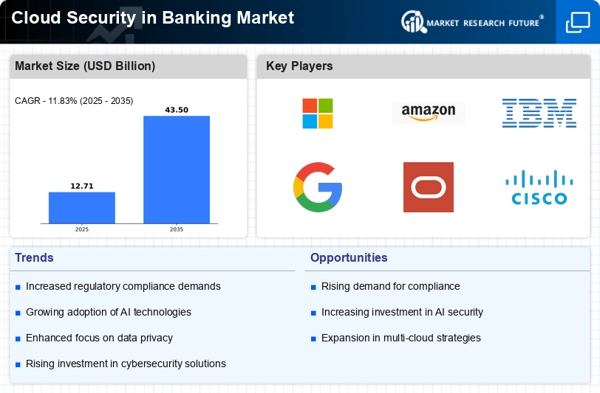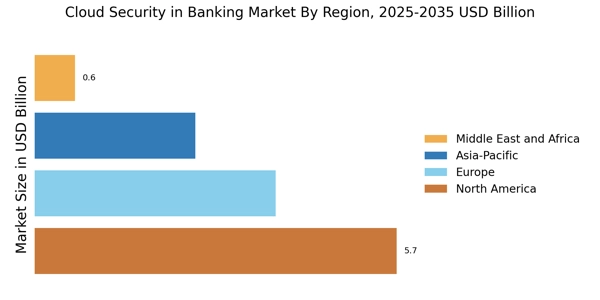The Cloud Security in Banking Market is currently characterized by a dynamic competitive landscape, driven by the increasing demand for secure digital banking solutions and the rapid adoption of cloud technologies. Major players such as Microsoft (US), Amazon (US), and IBM (US) are strategically positioned to leverage their technological prowess and extensive resources. Microsoft (US) focuses on innovation through its Azure cloud platform, emphasizing security features tailored for financial institutions. Amazon (US) continues to expand its AWS offerings, enhancing security protocols to meet regulatory requirements. IBM (US) is concentrating on mergers and acquisitions to bolster its cloud security capabilities, particularly in the banking sector. Collectively, these strategies contribute to a competitive environment that is increasingly focused on technological advancement and regulatory compliance.
In terms of business tactics, companies are localizing their operations and optimizing supply chains to enhance service delivery and responsiveness to market needs. The competitive structure of the Cloud Security in Banking Market appears moderately fragmented, with several key players exerting influence. This fragmentation allows for a diverse range of solutions, catering to various banking institutions' specific security requirements, while also fostering innovation through competition.
In August 2025, Microsoft (US) announced a significant partnership with a leading financial services firm to develop a new suite of cloud security solutions tailored for banking applications. This collaboration is expected to enhance Microsoft's market position by integrating advanced security features directly into banking operations, thereby addressing the growing concerns around data breaches and compliance. The strategic importance of this partnership lies in its potential to set new standards for security in cloud banking, positioning Microsoft as a leader in this niche.
In September 2025, Amazon (US) unveiled its latest security enhancements for AWS, specifically designed for the banking sector. This update includes advanced encryption technologies and real-time threat detection capabilities. The strategic relevance of this move is profound, as it not only strengthens Amazon's competitive edge but also reassures banking clients of their commitment to safeguarding sensitive financial data. Such innovations are likely to attract more financial institutions to AWS, further solidifying Amazon's market share.
In October 2025, IBM (US) completed the acquisition of a cybersecurity firm specializing in AI-driven security solutions for financial services. This acquisition is pivotal, as it allows IBM to integrate cutting-edge AI technologies into its existing cloud security offerings, enhancing its ability to predict and mitigate potential threats. The strategic implications of this acquisition suggest that IBM is positioning itself to lead in the integration of AI within cloud security, a trend that is becoming increasingly critical in the banking sector.
As of October 2025, the competitive trends in the Cloud Security in Banking Market are heavily influenced by digitalization, sustainability, and the integration of artificial intelligence. Strategic alliances are becoming more prevalent, as companies recognize the need to collaborate to enhance their technological capabilities and market reach. Looking ahead, competitive differentiation is likely to evolve from traditional price-based competition to a focus on innovation, advanced technology, and the reliability of supply chains. This shift underscores the importance of not only meeting regulatory standards but also exceeding customer expectations through superior security solutions.


















Leave a Comment